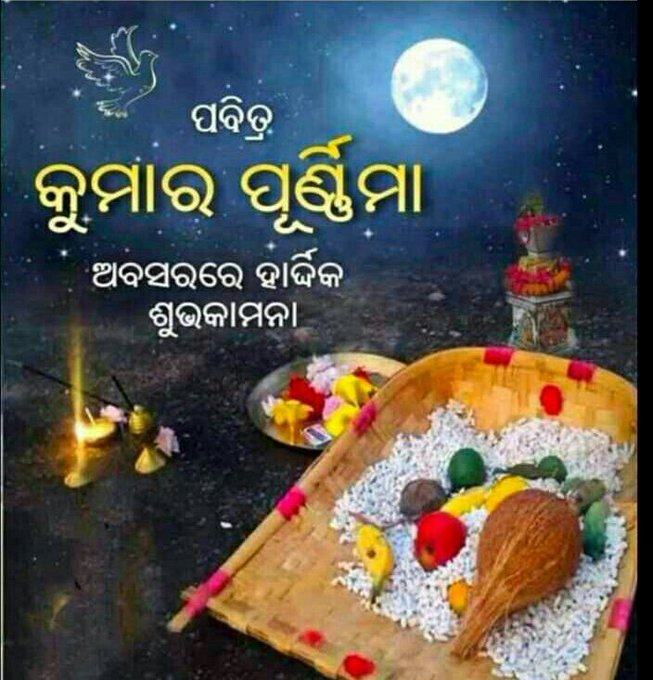Kumara Purnima in Odisha Celebrating , also known as Kumar Utsav or Kartik Purnima, is a vibrant festival celebrated with great joy and enthusiasm in the eastern state of Odisha, India. This auspicious occasion falls on the full moon day of the Hindu month of Kartik (October-November). Kumara Purnima holds immense cultural and religious significance, symbolizing the celebration of youth, harvest, and divine love.

The festival of Kumara Purnima has deep roots in Hindu mythology and folklore. It commemorates the divine love between Lord Kartikeya, also known as Kumar, and the celestial nymphs called Kinnaras. As per the legends, it was on this day that Lord Kartikeya, the son of Lord Shiva and Goddess Parvati, married the beautiful and graceful Kinnara princesses.
Preparations for Kumara Purnima begin well in advance. The festivities are primarily centered around the worship of Lord Kartikeya, who is revered as the god of war, bravery, and valor. Devotees clean their homes and decorate them with colorful rangolis (decorative patterns made from colored powders) and flowers. Elaborate pandals (temporary structures) are erected in communities, adorned with vibrant decorations and illuminated with lights.
On the day of Kumara Purnima, devotees wake up early before sunrise and take a ceremonial bath in rivers, lakes, or sacred ponds. This act of purification is believed to cleanse both the body and the soul. After the bath, people offer prayers to Lord Kartikeya, seeking his blessings and guidance for strength, courage, and success in life.
One of the prominent rituals observed during Kumara Purnima is the lighting of lamps. Earthen lamps filled with oil are lit and placed in rows, creating a mesmerizing sight after sunset. These lamps symbolize the triumph of light over darkness, knowledge over ignorance, and good over evil. The glowing lamps not only add to the festive ambience but also evoke a sense of spiritual awakening.
You can read our another post on Ratha Jatra in Odisha Festival

Kumara Purnima is also associated with agriculture and the harvest season. It is believed that on this day, the farmers offer their gratitude to Mother Earth for providing bountiful crops. In rural areas, people participate in various agricultural activities such as sowing seeds or transplanting seedlings. The festival serves as a reminder of the close bond between human beings and nature, emphasizing the importance of preserving and nurturing the environment.
Another fascinating aspect of Kumara Purnima is the tradition of boat racing. Colorfully-decorated boats, known as “Boita,” are set afloat in rivers and water bodies. This ritual is inspired by ancient maritime trade history when Odisha was known for its rich maritime heritage. The boats carry tiny clay lamps, flowers, and offerings, symbolizing the journey of merchants and traders in ancient times. Boat races are organized, adding excitement and fervor to the festivities.
Kumara Purnima is also a joyous celebration for children and young adults. They indulge in outdoor games, cultural performances, and traditional dances. Young girls dress up in vibrant attire and adorn themselves with beautiful jewelry. They swing on decorated swings, singing melodious folk songs, and immersing themselves in the spirit of the festival.
More: Wanted to download Odishashop.com visit here

The festival concludes with the distribution of prasad (sacred food offering) to devotees. Sweets, fruits, and other delicacies are shared as a token of goodwill and blessings. Communities come together to feast and celebrate, fostering a sense of unity and camaraderie.
Write A FAQ For Kumara Purnima in Odisha Celebrating
What is Kumara Purnima and how is it celebrated in Odisha?
Kumara Purnima is a festival celebrated in Odisha to honor Lord Kartikeya, the Hindu God of war and victory. It usually falls on the full moon day in the month of Ashadha (June-July). On this day, people offer prayers and perform rituals to seek the blessings of Lord Kartikeya.
What are the main rituals associated with Kumara Purnima in Odisha?
One of the main rituals of Kumara Purnima is the offering of water to the Sun God. People wake up early in the morning and take a holy dip in rivers or ponds, and then offer water to the Sun God. It is believed that this ritual cleanses the soul and brings good fortune.
How is Kumara Purnima celebrated by the young girls in Odisha?
Kumara Purnima holds special significance for young girls in Odisha. They observe a fasting ritual to seek a suitable husband. They create small boats made of banana stems, decorate them with flowers, and place a lamp on it. These boats are then floated on a water body, symbolizing the journey of love and marriage.
Are there any regional variations in the way Kumara Purnima is celebrated in Odisha?
Yes, there are some regional variations in the way Kumara Purnima is celebrated in Odisha. In some parts, young boys and girls participate in a traditional game called ‘Puchi Khela’ where they grab each other’s hands in a circle and dance. In other regions, people organize cultural events and musical performances to celebrate the festival.
What is the significance of Kumara Purnima in Odisha?
Kumara Purnima is believed to be a festival that brings happiness, prosperity, and success. It is said that offering water to the Sun God on this day fulfills desires and removes any obstacles in life. The festival also promotes the concept of love, union, and marriage, making it an important event for young boys and girls in Odisha.
Conclusion
In conclusion, Kumara Purnima in Odisha is a cherished festival that celebrates youth, harvest, and divine love. It brings together elements of mythology, spirituality, agriculture, and cultural traditions. The festival is a vibrant display of devotion, gratitude, and the joy of communal celebration. Kumara Purnima serves as a reminder to embrace youthful energy, express gratitude for nature’s abundance, and cultivate divine love in our hearts.
